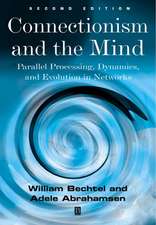Models of Neural Networks: Temporal Aspects of Coding and Information Processing in Biological Systems: Physics of Neural Networks
Editat de Eytan Domany, J. Leo van Hemmen, Klaus Schultenen Limba Engleză Hardback – 17 mar 1995
| Toate formatele și edițiile | Preț | Express |
|---|---|---|
| Paperback (1) | 947.67 lei 6-8 săpt. | |
| Springer – 19 sep 2011 | 947.67 lei 6-8 săpt. | |
| Hardback (1) | 953.52 lei 6-8 săpt. | |
| Springer – 17 mar 1995 | 953.52 lei 6-8 săpt. |
Preț: 953.52 lei
Preț vechi: 1162.82 lei
-18% Nou
Puncte Express: 1430
Preț estimativ în valută:
182.46€ • 195.11$ • 152.13£
182.46€ • 195.11$ • 152.13£
Carte tipărită la comandă
Livrare economică 18 aprilie-02 mai
Preluare comenzi: 021 569.72.76
Specificații
ISBN-13: 9780387943626
ISBN-10: 0387943625
Pagini: 347
Ilustrații: XVI, 347 p.
Dimensiuni: 155 x 235 x 24 mm
Greutate: 0.68 kg
Ediția:1994
Editura: Springer
Colecția Springer
Seria Physics of Neural Networks
Locul publicării:New York, NY, United States
ISBN-10: 0387943625
Pagini: 347
Ilustrații: XVI, 347 p.
Dimensiuni: 155 x 235 x 24 mm
Greutate: 0.68 kg
Ediția:1994
Editura: Springer
Colecția Springer
Seria Physics of Neural Networks
Locul publicării:New York, NY, United States
Public țintă
ResearchCuprins
1. Coding and Information Processing in Neural Networks.- 1.1 Description of Neural Activity.- 1.2 Oscillator Models.- 1.3 Spiking Neurons.- 1.4 A Network of Spiking Neurons.- 1.5 Hebbian Learning of Spatio-Temporal Spike Patterns.- 1.6 Summary and Conclusions.- References.- 2. The Correlation Theory of Brain Function.- Foreword.- 2.1 Introduction.- 2.2 Conventional Brain Theory.- 2.3 The Correlation Theory of Brain Function.- 2.4 Discussion.- References.- 3. Firing Rates and Well-Timed Events in the Cerebral Cortex.- 3.1 Measuring the Activity of Nerve Cells.- 3.2 Rate Functions and Stationary Point Processes.- 3.3 Rate Functions for Nonstationary Point Processes.- 3.4 Rate Functions and Singular Events.- References.- 4. The Role of Synchrony in Neocortical Processing and Synaptic Plasticity.- 4.1 Introduction.- 4.2 Pattern Processing and the Binding Problem.- 4.3 Evidence for Dynamic Interactions Between Spatially Distributed Neurons.- 4.4 Stimulus-Dependent Changes of Synchronization Probability.- 4.5 Synchronization Between Areas.- 4.6 The Synchronizing Connections.- 4.7 Experience-Dependent Modifications of Synchronizing Connections and Synchronization Probabilities.- 4.8 Correlation Between Perceptual Deficits and Response Synchronization in Strabismic Amblyopia.- 4.9 The Relation Between Synchrony and Oscillations.- 4.10 Rhythm Generating Mechanisms.- 4.11 The Duration of Coherent States.- 4.12 Synchronization and Attention.- 4.13 The Role of Synchrony in Synaptic Plasticity.- 4.14 The Role of Oscillations in Synaptic Plasticity.- 4.15 Outlook.- 4.16 Concluding Remarks.- References.- 5. Associative Binding and Segregation in a Network of Spiking Neurons.- 5.1 Introduction.- 5.2 Spike Response Model.- 5.3 Theory of Locking.- 5.4 Simulation Results.- 5.5 Application to Binding and Segmentation.- 5.6 Context Sensitive Binding in a Layered Network with Feedback.- 5.7 Discussion.- 5.8 Conclusions.- References.- 6. Modeling the Sensory Computations of the Olfactory Bulb.- 6.1 Introduction.- 6.2 Anatomical and Physiological Background.- 6.3 Modeling the Neural Oscillations in the Olfactory Bulb.- 6.4 A Model of Odor Recognition and Segmentation in the Olfactory Bulb.- 6.5 A Model of Odor Segmentation Through Odor Fluctuation Analysis.- 6.6 Discussion.- References.- 7. Detecting Coherence in Neuronal Data.- 7.1 Introduction.- 7.2 Time Resolved Detection of Coherence.- 7.3 Memory and Switching in Local Field Potentials from Cat Visual Cortex.- 7.4 A Model-Dependent Approach.- 7.5 Memory and Switching in Multiunit Activities from Cat Visual Cortex.- 7.6 Reconstruction of Synchronous Network States.- 7.7 Summary.- References.- 8. Hebbian Synaptic Plasticity: Evolution of the Contemporary Concept.- 8.1 Concept of a Hebbian Synapse.- 8.2 Experimental Evidence for Hebbian Synaptic Mechanisms.- 8.3 Biophysical Models of LTP Induction.- 8.4 Bidirectional Regulation of Synaptic Strength.- 8.5 Interaction Between Dendritic Signaling and Hebbian.- Learning.- References.- 9. Reentry and Dynamical Interactions of Cortical Networks.- 9.1 Introduction.- 9.2 Models of Cortical Integration.- 9.3 Summary and Conclusion.- References.


















